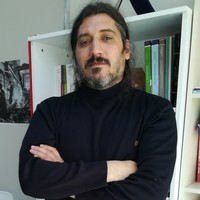Papers by Codrina Laura Ionita
Multiculturalism and the Convergence of Faith and Practical Wisdom in Modern Society

Traditional architecture has always had a simple and austere line in terms of proportions, ratio ... more Traditional architecture has always had a simple and austere line in terms of proportions, ratio among volumes, colour and even materials. The stylistic unit was found in all country elements, from the inside to the outside of the house, the fountain, shed or fence. There are cases where the tradition survives in the current forms, as for instance in a village in Suceava, where all the motifs in which the new homes are decorated are borrowed from geometric models or crop stylizations on the shirts and blouses of the peasants. In general, however, the upgrades of the houses suffer from a contagious disease called kitsch. Defined as an aesthetic mismatch, kitsch is reflected in the architecture either in the form of mismatch of various materials of the same house, either as disharmony among styles (or lack of style) of the components of the same complex, or as a gap between shape or construction materials and where it is located, or as a discrepancy between the modern improvements and the cultural purpose of an edifice. Causes of the appearance of kitsch can be: contemporary rush for the fulfilment of material requirements (translated into an increasingly greater need for physical comfort), the desire for imitation of luxury, of wealth (leading to counterfeiting and forgery and lie), the need for permanent change that comes from the total collapse of the system of values. Behind all this apparently social causes there is a serious spiritual deficiency of the human being. Kitsch is nothing but an external image of an inner disharmony caused by passions such as greed, comfort, idleness, pride, hypocrisy or vain glory. Getting rid of the kitsch must begin with cleansing the spirit of the passion that corrodes it.

In Husserl’s continuous stream of thoughts, J.-L. Marion comes to define, within the contemporary... more In Husserl’s continuous stream of thoughts, J.-L. Marion comes to define, within the contemporary phenomenology, the saturated phenomenon (the historic event being an exemplary saturated phenomenon) as a phenomenon in which the intentional self is no longer a constituent, and neither does it summarize the institution through an object defined by a horizon. The historic event is for J.L. Marion a saturated phenomenon that gives enough by itself, without cause, without intervention and without foresight.
Almost in the same terms as the French philosopher, the historical event was sensed by L. Tolstoy in War and Peace. For the Russian writer, the historic event of the French invasion of Russia in 1812 has no precise cause. It bursts by itself and by itself, it expands, it imposes, it stops, it withdraws and it goes off. The burst and the causality of the event remain as inexplicable as its coming to an end, and this imposing of the phenomenon’s independence over any human will is also found in contemporary phenomenology, where the event becomes a model for the entire phenomenology.
”The Burning Bush”, a symbol of epiphany, a place of getting out of the hiding place, of ”revelat... more ”The Burning Bush”, a symbol of epiphany, a place of getting out of the hiding place, of ”revelationi”, of the sacred moment from Horeb Mountain, when God first spoke to Moses, becomes the emblematic image for the spiritual movement with the same name, launched in 1943 by Sandu Tudor at Antim Monastery, Romania. The icon ”The Burning Bush of Virgin Mary” brought to Antim by the monk Ioan Kulîghin, was almost always present at the group’s meetings, being the embodiment of the passion for knowledge and divine experience. A sign of the appearance of the sacred among secular things, the image of the Virgin Mary in the middle of the burning bush which does not destroy, but brings to salvation, is re-used in contemporary iconography, in works which confess the same passion for the heavenly Country.

In traditional thinking human existence was conceived like a fall from a state of grace as a cons... more In traditional thinking human existence was conceived like a fall from a state of grace as a consequence to the original sin. Thus, life did not have any other purpose, but to recovering the initial state by healing off the disease of becoming and ephemeral. Holy places or objects have always mediated the contact between the human being and the absolute, seen as the only true reality. Expression of the “sacred”, the icon becomes a way of spiritual healing, implicitly a way to heal the soul. Therefore, all the levels at which it can be deciphered do not have another purpose but to justify this function. From a formal perspective of the elements that make up the image, the sacred is suggested by some geometrical forms, with colors having a symbolic value or by relations considered perfect, relations and proportions that are to be found again in the intimate structure of the whole universe and of the human being itself. That is why the contemplation of an icon determines the resonance with its enciphered rhythms meeting the need for the sacred, and harmonizes the human being. Phenomenologically, the icon proves to be a place of presence, of meeting. It plays the part of being a transition to the transcendent. The look of the bystander crosses the visible and the objective in order to meet a prototype which is not an original or a second visible beyond the first one, but it is a second look which penetrates the materiality of the icon. This second look is a commanding authority to the one perceiving it. It is the light of the invisible divine eye, which lightens and purifies the spirit of the one contemplating it.

The importance granted to this topic beginning with the modern period, in philosophy as well as i... more The importance granted to this topic beginning with the modern period, in philosophy as well as in art, seems undisputable. Nevertheless, with the phenomenology of the 20th century, the concepts of relation and otherness progressively question the authority of the Self. From the immanent transcendence or transcendence as a fundamental state of the Dasein, to the adonat as tributary to a given phenomenon, the subject progressively loses its active role, in favor of otherness. From the perspective of art, the shifting of the focus from subjectivity to otherness is achieved, on the one hand, via the importance granted to the object, and on the other hand, via perceiving the artist as a receiver, and not as a creator. According to the phenomenological interpretation, art is not the product of the artist, but a revelation, a coming into the material of something that is already present without being noticeable, a relation, an event or a saturated phenomenon which occurs, which offers itself to the subject without giving the latter the possibility of interfering.

Going back to medieval spirituality seems to be a common feature of the artistic currents, claime... more Going back to medieval spirituality seems to be a common feature of the artistic currents, claimed from romanticism: expressionism, abstract expressionism or neo-expressionism. In romanticism the aspiration toward the absolute was obvious. In expressionism the place dedicated to the divinity is found here empty, and art becomes a cry of despair in the face of solitude. Abstract expressionism will not even try to aim for transcendence, but will probe the interiority, subjectivity and reaction of the human being in the midst of being. However, there are artists in the abstract expressionism whose art expresses the harmony of the human being in the middle of the cosmos. An example is the art of J. Pollock for which not only the artistic image itself, but also the technique, the dripping, and the means of working become expressions of the cosmic harmony. Along with art, in science (F. Capra) or in medieval mysticism there is the same need of communion with nature, spiritualization of the world, which is the first step on the path to divinity.
The question of limit, so obsessing in the contemporary art, can be understood like a perpetual t... more The question of limit, so obsessing in the contemporary art, can be understood like a perpetual temptation to surpassing the human condition as a bound between the real and the ideal.
Donation of the Art or the Condition of Describing Phenomenality in J.-L. Marion
The possibility... more Donation of the Art or the Condition of Describing Phenomenality in J.-L. Marion
The possibility to describe feelings of consciousness is determined, in E.Husserl, by certain fundamental features of consciousness: intentionality, synthesis, horizon or the fact of being constituent.
By favouring donation to intentionality, J.-L.Marion opens the limits of phenomenality towards a phenomenon which donates itself by excess of intuition, the saturated phenomenon. The conditions necessary for describing a phenomenon are not denied by J.-L.Marion. Their meaning is, however, changed. The saturated phenomenon, whose example can be seen in the work of art, donates itself through an instant summary, due to superabundant insights, within several horizons, and without being able to be made up by a founder ego.
Beyond the Visible or the Abstraction in Art. Visible seems to be
fundamental in masterpiece. How... more Beyond the Visible or the Abstraction in Art. Visible seems to be
fundamental in masterpiece. However phenomenological thinking often considers invisible as being essential. The masterpiece offers the viewer the opportunity to “see” the own view (E. Ecoubas), to live the “feeling of life” (M. Henry) or to “feel” the moment the phenomenon appears (H. Maldiney). Analysis on some of K. Malevitch’s writings reveals the fact that the Russian artist himself conceived art as a way of searching interiority and self-retrieval. The text of the Suprematist manifest of 1915 describes almost in the same terms as those of mystical writings
the act of detaching progressively from the real world and keeping only the “sensitivity” perceived as pure living.

Abstract
“The death of man” or the “end of history”, strongly claimed by postmodern conception, h... more Abstract
“The death of man” or the “end of history”, strongly claimed by postmodern conception, have not however managed to destroy the faith in the spiritual essence of man. Although not belonging to the same area, M. Eliade’s ideas reappear with great strength in the philosophical thinking that was a follower of the French phenomenology. The analysis of the various religious conceptions and manifestations leads M. Eliade to the concept of homo religiosus, who is considered to be the man for whom the meaning of his existence only lies in his relation with the absolute, as it is this relation that enables him to have access to cosmic reintegration and self-knowledge. J.-L. Marion’s philosophical thinking starts from donation as a principle of phenomenality to get to adonat. He is that one that cancels the founder role of consciousness and thus finds himself as being the one that receives himself from what he receives. The adonat thus finds the way to be in the world of homo religiosus.
In a good tradition of German expressionism, the artist Anselm Kiefer in his art continues the in... more In a good tradition of German expressionism, the artist Anselm Kiefer in his art continues the interrogations both over his own ego and regarding his membership on a specific nation as well. Through his art, Anselm Kiefer testified that he tried to comprehend himself and to understand his relationship to his own nation, the German. This self-scanning starts from the understanding of the key moments of Germanic history which build the warrior and chivalrous spirit of the nation. Medieval myths and legends are a first moment in our understanding of this ethnic structure, followed by experimenting some gestures belonging to the recent history, where nationalism calls into question how the German nation is related to other nations. Anselm Kiefer’s art is revealed as an awareness and understanding of being a nation.
Books by Codrina Laura Ionita









Uploads
Papers by Codrina Laura Ionita
Almost in the same terms as the French philosopher, the historical event was sensed by L. Tolstoy in War and Peace. For the Russian writer, the historic event of the French invasion of Russia in 1812 has no precise cause. It bursts by itself and by itself, it expands, it imposes, it stops, it withdraws and it goes off. The burst and the causality of the event remain as inexplicable as its coming to an end, and this imposing of the phenomenon’s independence over any human will is also found in contemporary phenomenology, where the event becomes a model for the entire phenomenology.
The possibility to describe feelings of consciousness is determined, in E.Husserl, by certain fundamental features of consciousness: intentionality, synthesis, horizon or the fact of being constituent.
By favouring donation to intentionality, J.-L.Marion opens the limits of phenomenality towards a phenomenon which donates itself by excess of intuition, the saturated phenomenon. The conditions necessary for describing a phenomenon are not denied by J.-L.Marion. Their meaning is, however, changed. The saturated phenomenon, whose example can be seen in the work of art, donates itself through an instant summary, due to superabundant insights, within several horizons, and without being able to be made up by a founder ego.
fundamental in masterpiece. However phenomenological thinking often considers invisible as being essential. The masterpiece offers the viewer the opportunity to “see” the own view (E. Ecoubas), to live the “feeling of life” (M. Henry) or to “feel” the moment the phenomenon appears (H. Maldiney). Analysis on some of K. Malevitch’s writings reveals the fact that the Russian artist himself conceived art as a way of searching interiority and self-retrieval. The text of the Suprematist manifest of 1915 describes almost in the same terms as those of mystical writings
the act of detaching progressively from the real world and keeping only the “sensitivity” perceived as pure living.
“The death of man” or the “end of history”, strongly claimed by postmodern conception, have not however managed to destroy the faith in the spiritual essence of man. Although not belonging to the same area, M. Eliade’s ideas reappear with great strength in the philosophical thinking that was a follower of the French phenomenology. The analysis of the various religious conceptions and manifestations leads M. Eliade to the concept of homo religiosus, who is considered to be the man for whom the meaning of his existence only lies in his relation with the absolute, as it is this relation that enables him to have access to cosmic reintegration and self-knowledge. J.-L. Marion’s philosophical thinking starts from donation as a principle of phenomenality to get to adonat. He is that one that cancels the founder role of consciousness and thus finds himself as being the one that receives himself from what he receives. The adonat thus finds the way to be in the world of homo religiosus.
Books by Codrina Laura Ionita
Almost in the same terms as the French philosopher, the historical event was sensed by L. Tolstoy in War and Peace. For the Russian writer, the historic event of the French invasion of Russia in 1812 has no precise cause. It bursts by itself and by itself, it expands, it imposes, it stops, it withdraws and it goes off. The burst and the causality of the event remain as inexplicable as its coming to an end, and this imposing of the phenomenon’s independence over any human will is also found in contemporary phenomenology, where the event becomes a model for the entire phenomenology.
The possibility to describe feelings of consciousness is determined, in E.Husserl, by certain fundamental features of consciousness: intentionality, synthesis, horizon or the fact of being constituent.
By favouring donation to intentionality, J.-L.Marion opens the limits of phenomenality towards a phenomenon which donates itself by excess of intuition, the saturated phenomenon. The conditions necessary for describing a phenomenon are not denied by J.-L.Marion. Their meaning is, however, changed. The saturated phenomenon, whose example can be seen in the work of art, donates itself through an instant summary, due to superabundant insights, within several horizons, and without being able to be made up by a founder ego.
fundamental in masterpiece. However phenomenological thinking often considers invisible as being essential. The masterpiece offers the viewer the opportunity to “see” the own view (E. Ecoubas), to live the “feeling of life” (M. Henry) or to “feel” the moment the phenomenon appears (H. Maldiney). Analysis on some of K. Malevitch’s writings reveals the fact that the Russian artist himself conceived art as a way of searching interiority and self-retrieval. The text of the Suprematist manifest of 1915 describes almost in the same terms as those of mystical writings
the act of detaching progressively from the real world and keeping only the “sensitivity” perceived as pure living.
“The death of man” or the “end of history”, strongly claimed by postmodern conception, have not however managed to destroy the faith in the spiritual essence of man. Although not belonging to the same area, M. Eliade’s ideas reappear with great strength in the philosophical thinking that was a follower of the French phenomenology. The analysis of the various religious conceptions and manifestations leads M. Eliade to the concept of homo religiosus, who is considered to be the man for whom the meaning of his existence only lies in his relation with the absolute, as it is this relation that enables him to have access to cosmic reintegration and self-knowledge. J.-L. Marion’s philosophical thinking starts from donation as a principle of phenomenality to get to adonat. He is that one that cancels the founder role of consciousness and thus finds himself as being the one that receives himself from what he receives. The adonat thus finds the way to be in the world of homo religiosus.